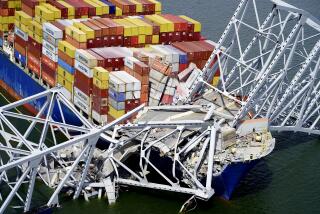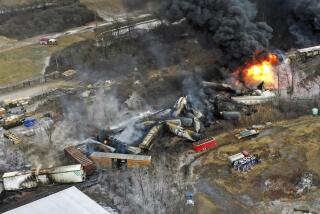Blow by Barge in Fog Is Suspected in Train Crash
SARALAND, Ala. — Officials concluded Thursday that a barge, being pushed by a towboat lost in fog on an Alabama bayou, smacked into a railroad trestle and knocked concrete out of an abutment minutes before the Amtrak Sunset Limited roared across and plunged off, killing 44 people.
Investigators said they found that tracks on the trestle had been displaced by 41 inches in the direction the towboat was traveling. Capt. Michael Perkins of the U.S. Coast Guard said that the blow from the barge could have caused this misalignment--and derailed the train.
A call radioed by the towboat operator after the wreck, taped by the Coast Guard and obtained by The Times, shows that the operator cried out: “Mayday! Mayday! I’ve lost my (barge). There’s too much fog. I don’t know my exact location.” Moments later, the operator added: “There’s a train just ran off the track. There’s a lot of people in the water.
“There’s a fire. We need help. Get out here!”
The barge, being pushed by the towboat early Wednesday through a pre-dawn fog, clearly had crashed into the trestle abutment, officials said. “The barge did hit the bridge,” declared U.S. Transportation Secretary Federico Pena. The FBI said criminal charges against the towboat operator are “a possibility”--but a prosecutor said it was too early to decide.
As rescuers resumed their search Thursday for more victims, they found the body of a girl who appeared to be about 5 years old floating in the bayou. Authorities offered differing casualty figures. But they agreed on a death toll of at least 44 and said three persons were still missing and presumed dead.
The train carried 189 ticketed passengers, 18 crew members and three infants who did not require tickets.
It was Amtrak’s worst train wreck. The final toll could exceed the cumulative total of 48 people killed in all crashes in Amtrak history. Seven victims remained hospitalized, five in guarded condition. Most of the dead were found in train cars, but rescuers said the three missing people were believed to be crew members in the cab of the lead locomotive.
Rescuers maneuvered barge cranes into place to stabilize the cars in the bayou before divers crawled inside. They lifted a coach car out of the water and placed it on a barge. Lifting the lead locomotive, 69 feet long, could take days. Two thirds of it--including its nose, which carried a data recorder--is buried in 25 feet of water and 15 feet of silt.
The wreck was being investigated by the FBI, the National Transportation Safety Board, the Coast Guard and the police department in Mobile, 10 miles south of the accident scene.
Investigators described what happened this way:
The Mobile River flows past the city of Mobile. Towboat operator Andrew Stabler, who has been licensed for one year, was pushing three barges and pulling three others north, up the river. The barges were lashed three abreast and loaded with coal, coke and wood chips. He turned slightly left to go around 12 Mile Island, a heart-shaped spit of land north of the city.
Once he passed the island, instead of returning to his northward course, which would have taken him under 14 Mile Bridge, he continued left in the fog and unwittingly veered into Bayou Canot. At 3:06 a.m., he called the Coast Guard by radio telephone from his vessel, the MV Mauvilla, to say that he was lost.
“Mayday! Mayday!” Stabler says on a tape, made by the Coast Guard, which routinely records such calls. “I’ve lost my tow,” he says, referring to one of the barges he was pushing. “There’s too much fog. I don’t know my exact location. It’s just around 12 Mile Island, around the cut . . . “
The Coast Guard asks whether he needs assistance.
“Negative,” Stabler replies. “I don’t know what happened. I just saw the heel of the barge disappear. . . .”
Capt. Perkins of the Coast Guard said Thursday in an interview: “That’s when we think he hit the bridge.”
The tape shows that Stabler thought he was under 14 Mile Bridge, two miles farther north on the Mobile River--when in fact he was under the railroad trestle over Bayou Canot.
“We’re just under 14 Mile Bridge,” Stabler says. He pauses, then adds: “I don’t have time to talk. I’ll get back.”
He pauses again. “It’s real bad here. There’s a train just ran off the track.”
Another pause.
“There’s a train in the water. There’s a lot of people in the water. There’s a fire. We need help. Get out here!”
At 2:47 a.m., the train had passed the last signal along the tracks before the bridge. It was running 33 minutes late because of air-conditioning repairs in New Orleans. Had it not needed those repairs, investigators said, it might have crossed Bayou Canot before the barge hit the trestle.
The train, going 70 m.p.h., the speed limit, tried to make an emergency stop, said John Hammerschmidt, a member of the National Transportation Safety Board. Immediately afterward, at 2:48 a.m., he said, the conductor “gave a Mayday signal.”
But the attempt to stop was in vain. The lead locomotive, two other locomotives behind it and four of the eight cars on the train hurtled into the bayou.
According to these times, the train had been in the water for 18 minutes before Stabler called for help.
An assistant conductor walked through the four cars remaining on the tracks to a coach car hanging over the edge of the trestle. He realized what had happened and turned to passengers in the car.
“I need absolute quiet,” investigators quoted him as saying. “We need to work this like a school fire drill.”
He ordered the passengers to form a human chain. It moved carefully out of the car to safety, while the assistant conductor led others by the hand.
Outside, he stood in the spotlight of Stabler’s towboat, shining from about 150 to 200 yards downstream. He beckoned to the vessel. He then made his way toward it, investigators said, apparently swimming part of the way, and stayed with it while it shoved its barges to shore and made its way back to start pulling survivors out of the bayou.
The FBI said Stabler’s barges were found moored about a quarter of a mile from the crash site. “One of those barges has a big dent in it,” said Chuck Archer, special agent in charge of the FBI office in Mobile.
Archer said concrete had been broken away from an abutment of the bridge--and that pieces of concrete were found on one of the barges.
“The evidence seems to indicate,” Hammerschmidt said, “that the scrape marks on the barge and the scrape marks on the bridge match up.”
There was no reason for the towboat and barges to be in the bayou, which eventually becomes too shallow to be navigable, Archer said. Moreover, he said, there was too little room under the railroad trestle to accommodate vessels of that size.
“It (the lash-up of barges) wasn’t supposed to be there,” he said.
Bobby Hall, an FBI spokesman, said criminal charges might be filed against the towboat operator.
But Chris Galanos, district attorney for Mobile County, which has jurisdiction, said it was too early to decide.
“That the barge hit the bridge,” he said, “does not automatically mean that there’s criminal culpability.”
Stabler declined comment without his attorney’s consent.
“I’d like to tell my side,” he told the Associated Press. “People get things and turn them around.” He told the Birmingham, Ala., News: “We saved lives. We got people off who were hanging on the cars. My men put their lives on the line.”
The Warrior & Gulf Navigation Co. of Chickasaw, Ala., owner of the towboat, said Stabler had maneuvered his tug to rescue 17 survivors from the bayou. The firm pledged to cooperate with investigators but gave few details to reporters.
It issued a statement in which President Nicholas J. Barchie said: “We don’t yet know what happened.” Andy Harris, the firm’s terminal manager, said the towboat “found itself not in the river channel but in the Bayou Canot.
“Details are still unclear,” Harris said, “but the vessel was trying to return to the river as the Amtrak train approached the bridge where the accident occurred.”
Capt. Perkins said the towboat carried four crewmen. All have retained lawyers, Perkins said, and the lawyers have advised them not to discuss the matter.
Hammerschmidt said the NTSB wants to interview the crewmen, but he added: “We’re not that hopeful.”
Perkins, who released the firm’s statement to reporters, said company policy was to perform alcohol and blood tests on towboat operators and crew members after an accident.
He said he did not know if any results had been turned over to investigators.
Times staff writers Eric Harrison in Saraland and Richard E. Meyer in Los Angeles, as well as researcher Edith Stanley in Saraland, contributed to this story.
A Tragic Turn in the Fog
A miscalculated left turn into an unnavigable Alabama waterway by a barge early Wednesday morning may have cost more than 40 people their lives. According to investigators, heavy fog might have turned a routine trip upstream into tragedy.
HOW IT HAPPENED
1. A tugboat pushing 6 barges up the Mobile River report heavy fog. Tugboat operator is not aware he made a wrong turn.
2. The turn he makes takes him up the Bayot Canot, a smaller waterway.
3. A barge hits a concrete bridge abutment, possibly misaligning railroad tracks. Moments later, Amtrak’s Sunset Limited bound for Miami from Los Angeles derails at the bridge.
Source: Times staff; National Transportation Safety Board
More to Read
Sign up for Essential California
The most important California stories and recommendations in your inbox every morning.
You may occasionally receive promotional content from the Los Angeles Times.










